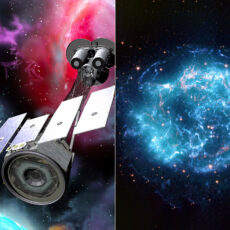
NASA’s Chandra X-ray Observatory captured an H-shaped structure and a supermassive black hole at the center of massive elliptical galaxy Messier 84 (M84). The black hole’s gravitational force captures gas, but some of it gets blasted away in the form of jets of particles that push out cavities in the hot gas.


The X-ray image you see here shows a map of the hot gas (pink) in and around Messier 84, reaching to within only about 100 light-years away from the black hole in the center of the galaxy. This gas radiates at temperatures at 10,000,000+ degrees, making it primarily observable in X-rays. As for the letter “H”, it measures around 40,000 light-years tall and reveals the jets streaking away from the black hole.
- 【12 in 1 Galaxy Projector】This star projector is capable of projecting 12 kinds of vivid starry sky scenes, creating a relaxed atmosphere and...
- 【Timing shut-off】You can set the star projector to turn off after 1 or 2 hours without worrying. Turn it on when you're trying to fall asleep. If...
- 【Clear images and comprehensive coverage】Star Projector can completely cover the ceiling or wall of a room, twisting the top screw ring to adjust...


M84 is a cousin of Messier 87 (M87), the galaxy containing the first black hole imaged with the global Event Horizon Telescope network, and, like M87, is also a member of the Virgo Cluster. The supermassive black hole in M84, along with those in our galaxy, M87, NGC 3115, and NGC 1600, are the only ones close enough to Earth, or massive enough, for astronomers to see details in Chandra images which are so near the black hole that gas should be falling inwards,” said NASA.










